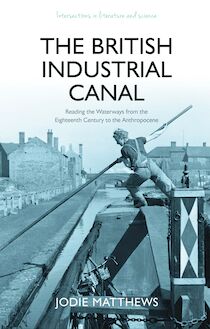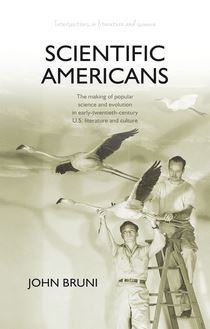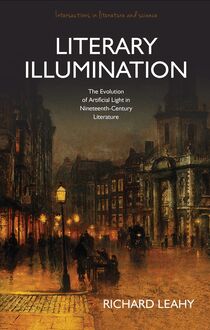The British Industrial Canal , livre ebook
129
pages
English
Ebooks
2023
Vous pourrez modifier la taille du texte de cet ouvrage
Obtenez un accès à la bibliothèque pour le consulter en ligne En savoir plus
Découvre YouScribe en t'inscrivant gratuitement
Découvre YouScribe en t'inscrivant gratuitement
129
pages
English
Ebooks
2023
Vous pourrez modifier la taille du texte de cet ouvrage
Obtenez un accès à la bibliothèque pour le consulter en ligne En savoir plus
Publié par
Date de parution
15 juin 2023
Nombre de lectures
1
EAN13
9781837720057
Langue
English
Thousands of literary, popular, non-fiction and archival texts since the eighteenth century document the human experience of the British industrial canal. This book traces networks of literary canal texts across four centuries to understand our relationships with water, with place, and with the past. In our era of climate crisis, this reading calls for a rethinking of the waterways of literature not simply as an antique transport system, but as a coal-fired energy system with implications for the present. This book demonstrates how waterways literature has always been profoundly interested in the things we dig out of the ground, and the uses to which they are put. The industrial canal never just connected parts of Britain: via its literature we read the ways in which we are in touch with previous centuries and epochs, how canals linked inland Britain to Empire, how they connected forms of labour, and people to water.
Acknowledgements
Chapter One: Introduction
Chapter Two: Practical Arts of the Waterways
Chapter Three: Colonizing Canal-Land
Chapter Four: Women, War, and the Waterways
Chapter Five: Waters of Life and Death
Chapter Six: The Basin, or Conclusion
Notes
Bibliography
Publié par
Date de parution
15 juin 2023
Nombre de lectures
1
EAN13
9781837720057
Langue
English
THE BRITISH INDUSTRIAL CANAL
INTERSECTIONS IN LITERATURE AND SCIENCE
Series Editors
Ruth Robbins, Leeds Beckett University
Susan Watkins, Leeds Beckett University
Editorial Board
Daniel Cordle, Nottingham Trent University
Clare Hanson, University of Southampton
George Levine, Rutgers University
Roger Luckhurst, Birkbeck, University of London
Alan Rauch, University of North Carolina at Charlotte
Simon Schaffer, University of Cambridge
Keir Waddington, Cardiff University
Do we still live in a world of ‘two cultures’, as C. P. Snow so memorably suggested in the late 1950s? Recent literary scholarship suggests that we don’t, though there do continue to be misunderstandings between scientists and humanities practitioners. This series is concerned with the intersections between literary research and scientific and technological advances. It is concerned with the ways in which science as a range of practices and philosophies, and technologies in all their guises, inform literary practice; in how science can also be challenged by literary practices and representations; and in what happens to each of these discourses when they are brought into play with each other. Literature and Science publishes pathfinding research which examines the conjunctions and disjunctions that occur when (possibly) different world views are brought together. It is our mission to bring to readers and scholars at all levels innovative thinking and writing about scientific and literary narratives that concern themselves with the medical humanities, ecocriticism, representations of technology and science fictions.
THE BRITISH INDUSTRIAL CANAL
READING THE WATERWAYS FROM THE EIGHTEENTH CENTURY TO THE ANTHROPOCENE
Jodie Matthews
© Jodie Matthews, 2023
All rights reserved. No part of this book may be reproduced in any material form (including photocopying or storing it in any medium by electronic means and whether or not transiently or incidentally to some other use of this publication) without the written permission of the copyright owner. Applications for the copyright owner’s written permission to reproduce any part of this publication should be addressed to the University of Wales Press, University Registry, King Edward VII Avenue, Cardiff CF10 3NS.
www.uwp.co.uk
British Library CIP Data
A catalogue record for this book is available from the British Library.
ISBN: 978-1-83772-003-3
eISBN: 978-1-83772-005-7
The right of Jodie Matthews to be identified as author of this work has been asserted in accordance with sections 77 and 79 of the Copyright, Designs and Patents Act 1988.
The publisher has no responsibility for the persistence or accuracy of URLs for any external or third-party internet websites referred to in this book, and does not guarantee that any content on such websites is, or will remain, accurate or appropriate.
Cover image: Aboard the canal barge ‘Heather Bell’ (1942)
© Imperial War Museum (D 7646)
Cover: Olwen Fowler
CONTENTS
Acknowledgements
1 Introduction
2 Practical Arts of the Waterways
3 Colonising Canal-Land
4 Women, War, and the Waterways
5 Waters of Life and Death
6 The Basin, or Conclusion
Notes
Bibliography
This book is dedicated to Roger, Belinda and Xanthe
ACKNOWLEDGEMENTS
I am grateful to have had opportunities to work through some of these ideas with academic and non-academic audiences; those ideas have undoubtedly been sharpened via the keen questions people were generous enough to pose. These occasions include Inland Waterways Association talks in Manchester and York, the Railway and Canal Historical Society conference in Birmingham (2017), the ‘Brindley 300’ conference at the National Waterways Museum, Ellesmere Port (2016), ‘Disrupted Histories, Recovered Pasts’ at Bath Spa University (2018), a ‘Learning at lunchtime’ talk on George Smith of Coalville at the National Waterways Museum in Gloucester (2018), and academic lectures at Portsmouth University, at Leeds Beckett University, for the Institute of Historical Research and for the ‘Water Works: The Arts of Water Management’ symposium at Northumbria University (2022). The international ‘Environment and Culture in Britain, 1688–1851’ forum, hosted by the University of Leeds, was an inspiring series to be part of in January 2022. Some thoughts about Sara Jeannette Duncan (Chapter Three) were tested out in Waterways Journal 23 (2021), though they are revised and extended here. Conversations with Maarja Kaaristo, Sarah Jasmon and Kerry Hadley-Pryce have poured into my readings. Thank you to the anonymous peer reviewers of my manuscript. Their suggestions were extremely useful; any mistakes and omissions are my own.
This research has been undertaken at, and largely funded by, the University of Huddersfield, on a campus with a canal running right through it. I am grateful for the research resources provided by the institution, including sabbaticals and funding to go to conferences and meetings. I am grateful, too, for the mentorship, support and good humour of my colleagues.
This book has been profoundly informed by my working relationship with the Canal & River Trust, and I thank everyone at the Trust who has been interested in my work and invited me to take part in fascinating canal-related projects. Most of all, this work is indebted to the volunteers who saved the canal network from ruin and who continue to care for it, and its archives and histories, today.
None of my academic work would be possible without the life-giving love of my family and friends, nor the people who allow Roger and me to combine parenting with other labours and pleasures, especially: my parents, Zena and Charlie Matthews, Helen Gildon, Amy Manley, the Solomous and the Stewarts. And, of course, PBC, who have been there for me forever and sustain me every day.
1
INTRODUCTION
Cutting a channel
I am Industrious . On board lives a couple in cramped contentment eased by reflections on oily water. When they try to describe their love, it feels sturdy, capacious, able to carry them: like a boat. 1 I am moored at Aspley Basin, near the entrance to a waterway that bore coal, lime, stone, timber, corn, textiles and more beneath England’s backbone. The basin was once all warehouses and cranes; horseshoes on stone and the shouts of working men. Today, I float in front of a Premier Inn, observed by businesspeople at the breakfast buffet. The water in which I sit is no longer polluted by the industry the canal originally served, but the air above has been thick with exhaust fumes from the ring road for decades. The motes of coal and black chimney smoke swirl no more over Huddersfield, but those invisible 400 ppm of CO 2 are cause for concern. Across the six lanes of buses, lorries, and cars, a building of glass and neon light leans out, more like the prow of a mammoth cruise ship crashing into the Giudecca Canal of Venice than my own subtle curves. From the perspective of the sixth floor, I appear completely still and picture perfect, only causing ripples large enough to see from up there when I am deliberately swung out from the moorings to traverse the waterway once more. My waters are a marker for those cocooned up there to the season’s offerings: glittering sunlight or creeping ice, beads of rain or leaves flopping on the surface. Up there, a figure turns reluctantly away from the view of me and back to her screen.
Canals are often referred to as ‘the Cut’. In her live-aboard boater memoir, Adrift (2016), Helen Babbs reflects on a stretch of London’s Regent’s Canal. She interprets Peter Ackroyd’s ‘liquid history’ as one that ‘isn’t tied to a single moment in time’, and suggests that the Cut ‘collects around and within it a multitude of buildings, objects, people, memories and ideas’. 2 This sense of liquid history, of the flow of the past into the present, is something this book aims to achieve in relation to the literature of Britain’s waterways. Its focus is the industrial canal, with a timeline beginning in 1761 and the opening of the aptly named Bridgewater Canal. Philip Bagwell has called this event ‘as dramatic a turning point in the history of British transport’ as the opening of the first intercity railway. 3 As Babbs’s book demonstrates, the canals do not exist solely as a practical transport network. They are laced through the landscape and have always induced people to think and write about them. A ‘gongoozler’ is someone who stares idly and at length at activity on a canal. In contrast, I reflect on generations of active thought about canals, the connections and implications writers have considered or unconsciously made.
Canals are diverse things to different people: place of work; home; leisure space; heritage; historical architecture; place of meditation; opportunity to encounter flora and fauna. They have had many other meanings, as I explore: symbol of industry, modernity, and the future; contested social space; a place for women to work like men; a landscape to explore and colonise; a place for self-exploration. In the readings I undertake, canals are powerfully metonymic. The book is more than a cultural history of the waterways, and less than a complete literary history of canals. It is an investigation into what this extraordinary human use of water does to our relationship with the industrial past, fractious present and climate-changed future, our sense of self and our place in the world. It involves an intricate and perhaps sometimes unexpected interweaving of ideas, themes, and historical periods in order to read the waterways. This reading takes us from soil to the imagined future, from pottery to the Anthropocene, from canoes to colonialism, from war to sugar, and from mussels to the self – with much more in between.
This introduction sets out some of the existing scholarship and key ideas that flow through my way of reading the waterways. These theories include affect theory, network theory, theorisation of materialit



